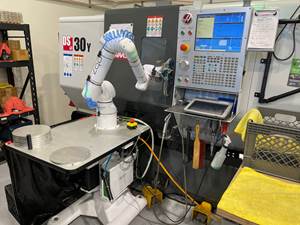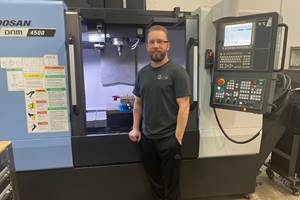Shopfloor Software Cuts Non-Productive Time And Increases On-Time Delivery
Palma Tool and Die Company has a full complement of CNC and manual machines, which includes VMCs, lathes, surface grinders, wire EDM and stamping and injection molding machines. Management was facing several issues. How do you make sure that materials are ordered and delivered on time? How do you shift production between machines to make sure that customers' jobs are delivered on time? And how quickly can you generate a progress report for your customer?
Palma Tool & Die Company (Lancaster, New York) has a full complement of CNC and manual machines, which includes VMCs, lathes, surface grinders, wire EDM and stamping and injection molding machines. Management was facing several issues. How do you make sure that materials are ordered and delivered on time? How do you shift production between machines to make sure that customers' jobs are delivered on time? And how quickly can you generate a progress report for your customer?
Palma's managers knew they had a problem when they couldn't determine job status without leaving their offices to check which operations were completed and which were not. Also, it became apparent that machinists were spending much too much time with administrative tasks, such as ordering materials and routing jobs.
"We had too much nonproductive time on the shop floor by employees that were supposed to be machining," says Stan Blaszak, general manager. "We wanted to get them back to machining and eliminate the paperwork. Also, we needed to improve our on-time deliveries, which required improved workflow and elimination of the guesswork in determining workload."
What the company needed was a system that would capture data and make it immediately available to managers. As a result, several shopfloor software management programs were evaluated. The critical issue was to find a shopfloor program that provided a complete solution, which included fully integrated job control, finite scheduling, real-time data collection and financial software. Smart Manager from Smart Shop Software (Post Falls, Idaho) was selected because it provided just such a solution to Palma's scheduling, resource planning and accounting needs.
"We didn't want to buy two or more programs and try to integrate them," says Mr. Blaszak. "What I like is that it's one system, so everything is tied together from start to finish. The estimate is tied to the production order and all the costing along with it so you have total tracking from beginning to end. Everything is accessible from your PC, so you don't have to go to three places in the shop for information. The customer gives us a purchase order, estimate or invoice number, and we can find everything that we need to know about the job."
Smart Manager, a 32-bit Windows 95/98/NT program, divides activities into three areas, including order processing; accounting; and scheduling and tracking. Each area is subdivided into tasks. For example, order processing includes estimating, sales orders, production orders, shipping, inventory, and so on. The system provides user configurable preferences, such as a customizable shop folder and form designer. A high level of security is built into the system, so pricing is available only to those who need to know and only authorized employees can add, edit and delete records.
"This was our first shopfloor management system," says Mr. Blaszak. "We knew from experience that implementation of any software takes several months of planning and several months before it would be operational."
Implementing software includes a certain amount of risk because the process can be difficult and traumatic. For example, as it becomes apparent that the old ways of doing things are not necessarily the best ways, processes must be changed. Of course, this means everybody in the shop has to learn new ways of performing tasks and become comfortable, as well as proficient, with new methods.
To help companies with implementation, the developers of Smart Manager software include consulting and implementation services with the purchase of their software. An initial site visit is made to evaluate the shop and processes, which allows process change and other problematic issues to be addressed in advance. Many suggestions are made that enable a smoother implementation process. Equally important is a review of current shop practices compared to operations under optimum conditions.
All of Palma's CNC machine tools are connected to the network via Ethernet cards, and manual machines are connected via bar code readers. Smart Manager monitors all the processes to deliver accounting, estimating and order entry, as well as real-time scheduling, tracking and report functions. The software facilitates productivity tracking, documentation and traceability for the company's ISO 9001 and QS 9000/9002 programs. Processes begin when an estimate, created with all the customer information, such as material requirements, processing steps, cycle times, delivery requirements and quantities, is entered into the system. Turning an estimate into a production order is done with one click of the mouse.
"Scheduling was the most important of all the modules, because we weren't doing that before," says Mr. Blaszak. "Accounting was done on another program. We decided not to move data from the old system to the new. We began the new system, and all new entries were made in it.
Implementation at Palma required approximately six weeks for advance planning after the initial site visit. Three months after the planning phase was completed, the software had been fully implemented, and employees were becoming familiar with the new system and processes. Machinists no longer had to write up routers, order materials and track jobs. Machinists now stay at their machines, while one person writes all the routers, orders materials and tracks the jobs.
People issues were the most difficult to overcome during implementation. Employees had become accustomed to handwritten routers, and schedules had always been verbal, often changing before the current job was finished. Accustomed to filling out router cards at the end of the day, now machinists had to key in information every time a job was completed and a new one was started. If the information were keyed at the end of the day, the system wouldn't work. In addition, employees had never seen a written schedule, so there was a credibility problem. Employees had to change their thought processes and modify behavior. Implementation required several months of monitoring the processes, as well as encouraging employees to adjust behavior patterns.
"Implementation was pretty much what we expected. It took a while for people to get used to scheduling because, in the past, we didn't have a schedule," says Mr. Blaszak. "What was being done by machinists part time is now done by one to two full-time people. We eliminated about 150 hours of non-productive time per week. That was the time machinists spent writing up routers and doing things other than machining. Now all their time is spent machining. Also, I found that since we have less people involved in how a workpiece is going to be made we have less rework and scrap."
One of the problems that Mr. Blaszak faced included prioritizing jobs. Without a scheduling system, jobs were bumped routinely as it seemed each customer's job became more important than the next. But bumping jobs affected on-time deliveries.
"Our delivery times have gone up from 78 percent on time to 88 percent, and we expect to get to 95 percent as we get the system fine tuned," says Mr. Blaszak. Tracking the history of a job is another benefit of the system. When a repeat order is placed, the history is immediately available. If there were difficulties involved with a job, they're captured by the system. An example might include combinations of speeds and feeds or other issues. So when a repeat order is placed, the router is reprinted and any mistakes made with the initial order can be corrected.
The scheduling process is based on a process plan, which supports multiple resources per operation. It's the only way to create schedules when different machines, molds and tooling must be combined to complete an operation. Workloads are scheduled evenly across equipment with similar capabilities through a resource substitution feature. Since the system is a true finite scheduler, manual resource leveling isn't required to balance capacity. In addition, operations that must be scheduled sequentially can be grouped.
"Now when people ask for a progress report on their job, I don't have to get up and run around the shop to figure out where it's at and what's left to do," says Mr. Blaszak. "I look at the computer screen and let them know exactly where it is, without leaving my office."
A critical aspect of ISO programs and keeping customers informed is the ability to generate reports. With the system's Smart Report Writer, many standard reports are available. Standard reports can be used as they are or as templates for creating custom reports. Virtually any required information can be extracted from the system. These examples include productivity reports, delivery reports, how many parts per hour, are employees all producing the same amount of parts and what did it take to produce the job last time compared to this time.
"It's very easy to write a custom report because the system is very flexible," says Mr. Blaszak. "You can generate a lot of comparisons to determine problems, such as does an employee need more training. And because you're not focused on how to get the information, more energy can be spent on making a better business decision."
Related Content
Shop Quotes Smarter, Works Harder with Machine Monitoring
Temco first installed MT-LINKi to optimize quoting. Now, the software helps the shop optimize its machines — and machine purchases.
Read MoreBecoming a More Efficient Shop With the Right Processes and Software
After refining its machining processes for more efficient production, this shop still needed a better way to track its data. Here's how it found a software solution.
Read More6 Machine Shop Essentials to Stay Competitive
If you want to streamline production and be competitive in the industry, you will need far more than a standard three-axis CNC mill or two-axis CNC lathe and a few measuring tools.
Read MoreImproving Workflows in Small Shops with Custom ERP
Small shops might not be ready for all of the functionality of an off-the-shelf ERP system, but modular, custom ERP programs can help improve workflow while providing the flexibility to change as shops grow.
Read MoreRead Next
The Cut Scene: The Finer Details of Large-Format Machining
Small details and features can have an outsized impact on large parts, such as Barbco’s collapsible utility drill head.
Read More3 Mistakes That Cause CNC Programs to Fail
Despite enhancements to manufacturing technology, there are still issues today that can cause programs to fail. These failures can cause lost time, scrapped parts, damaged machines and even injured operators.
Read More

















.png;maxWidth=300;quality=90)











